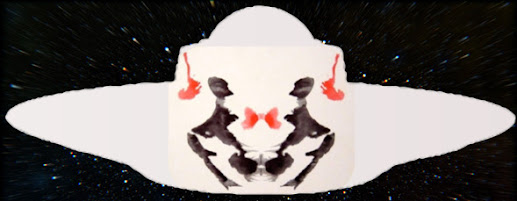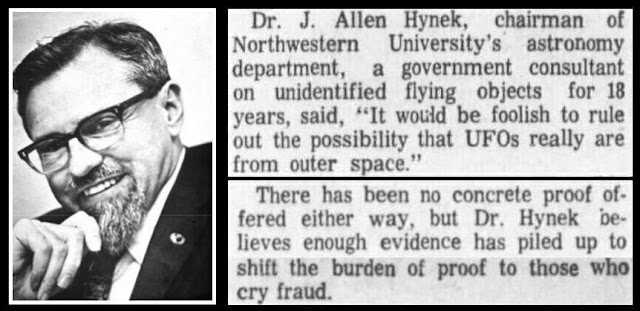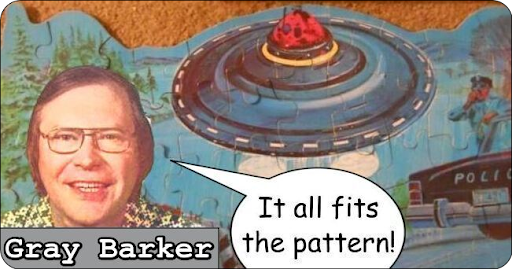James W. Moseley (1931-2012) got his start in ufology while
working on a
proposed flying saucer book. During 1953-54, he travelled throughout the USA
tracking down UFO witnesses, also interviewing authors of early saucer literature
and as well as prominent figures in clubs and research organizations. The book didn’t come together as planned, but with the connections and friendships Moseley
had cultivated, he launched a magazine dedicated to flying saucers
instead.
Jerome Clark wrote in his entry for Jim Moseley in The
UFO Encyclopedia Vol II: The Phenomenon from the Beginning, 1992:
With August Roberts and Dominic Lucchesi, Moseley founded Saucer News in July 1954, at first calling the magazine Nexus but changing it to the more self-explanatory title the next year. Saucer News was noted for its freewheeling, iconoclastic, personal style. In its pages Moseley praised friends, lashed out at enemies, exposed frauds and hoaxes (even perpetrating one himself, the notorious “Straith letter” [sent to] contactee George Adamski) and reported gleefully on the doings of ufology’s sane and not-so-sane. Saucer News was never less than entertaining, sometimes infuriating, but more often very funny. In 1968 the magazine was sold to flying saucer publisher Gray Barker. The last issue appeared four years later.
 |
| Jim Moseley and Gray Barker |
Issues of Saucer News are somewhat rare, but thanks to a former subscriber, there’s a large collection now available. The University of Wyoming hosts the papers of Frank Scully, which were recently shared online through their American Heritage Center. The collection includes scans of correspondence, "newsletters, magazine articles, comics, lecture ads, and more." Lots of good stuff, including a near complete run of Saucer News from 1954 to 1964.
The (preliminary) directory below is largely based on Jim Moseley’s
own listing of back issues. Besides the feature articles listed, each issue of Saucer News generally contained a summary of
UFO sightings and related news, a gossip and rumor roundup, photos, cartoons,
and listings of saucer clubs and conventions. Also, book reviews, as well as letters
from readers, often prominent figures in the saucer community.
The online digital collection hosted by the Archives For the Unexplained (AFU), curated by Isaac Koi. (Note: The links open PDFs, some files contain issues out of sequence.)
Saucer
News Archive
 |
| Saucer News (Nexus) 1-10, 1954-1955 |
AFU links to individual issues: Saucer News: Nexus
#l (July 1954) – First issue contains articles by James
Moseley and saucer pioneers August C. Roberts and Dominick Lucchesi.
#2 (Aug. 1954) - Contains interesting accounts of a
little-known saucer film taken in Africa, and of the activities of the Civilian
Saucer Intelligence of New York.
#3 (Sept. 1954) - Contains one of the most important
articles we have ever published, concerning a lady in Miami who claims to have
seen official government photographs of a crashed flying saucer from outer
space.
#4 (Oct. 1954) - Contains “The Flying Saucer Mystery –
solved” by James W. Moseley and “On the Fringe of the Supernatural” by Dominick
Lucchesi.
#5 (Nov. 1954) - “Analysis of the Lubbock [Lights] Incident”
by James W. Moseley and “Flying Saucers Fact and Fiction” by John P. Bessor.
#6 (Dec. 1954) - Contains “The Green Fireballs of the
Southwest” by “Dr. D.” (Leon Davidson), “Invasion from Space” by Richard Cohen,
“The Phantom Caravan by John P. Bessor, and “Jersey City’s Mystery Lights by August
C. Roberts.
#7 (Jan. 1955) - Contains editorial on William Dudley
Pelley and fascism, a report on “Two Meetings held by Civilian Saucer
Intelligence,” and a George Adamski exposé, “Some New Facts About ‘Flying
Saucers Have Landed’” by James W. Moseley.
#8 (Feb. 1955) - Contains a fascinating account of the
strange events which have occurred in recent years in the vicinity of Mount
Shasta, California.
#9 (March 1955) - Contains an interesting article by Frank
Scully, author of "Behind the Flying Saucers." (The Aztec
crash-retrieval hoax.)
#10 (April 1955) - Contains an important article by
the late Dr. Morris K. Jessup, author of several saucer books, whose mysterious
death is still a subject of controversy.
#11 (May 1955) - Contains an article by Desmond Leslie,
co-author with George Adamski of "Flying Saucers Have Landed." Also
contains the results of experiments in extrasensory perception conducted by the
Saucer News Staff. Also in this issue are articles by Dr. Morris K. Jessup
and Frank Scully.
 |
| Saucer News 1955-1957 |
#13 (Aug.-Sept. 1955) - Contains outstanding “UFOs, Atlantis, & The Antiquity of Civilized man” by Dr. M.K. Jessup, “A Parable” by Desmond Leslie, “A Report on the UFO's and Levitation” by John P. Bessor.
#14 (Oct.-Nov. 1955) – Contains “The
Sky Cross” by Frank Reid, “Concerning ‘Space, Gravity, and the Flying Saucer’"
by Desmond Leslie, “Are There Other Inhabited Planets?” by Justin Case, and “The
Green Fireballs of the Southwest” by “Dr. D.” (Leon Davidson).
#15 (Dec.-Jan. 1955-1956) – Contains “What on Earth
Were They?” by Harold T. Wilkins, “The ‘Little People' Case for the UFO” by M.K.
Jessup), and “Summary, Notes and comments on Project Blue Book Special Report
#14” by Justin Case and James W. Moseley.
#16 (Feb.-March 1956) – Contains “The Al Bender Story”
by James W. Moseley, “Conquest of Gravity is Aim of Top U.S. Scientists”
(Condensed from the N.Y. Herald-Tribune) comments by Justin Case, “The
Air Force and the Saucers - Part One” by “'Dr. D.” (Leon Davidson).
#17 (April-May, 19.56) - Contains an
interesting account of pre-World War II sightings by saucer researcher Frank
Reid.
#18 (June-July, 19.56) - A most important issue,
containing James Moseley's "Earth Theory" solution to the flying
saucer mystery.
#19 (Aug.-Sept. 1956) - Contains an interesting
article entitled "UFO’ s and Unnatural Clouds," by Frank Reid.
#20 (Oct.-Nov. 1956) - Contains another documented
account of pre-World War II sightings, by Frank Reid, and an article by the
noted French saucer author Aime Michel.
#21 (Dec.-Jan. 1956-57) - Contains an article entitled
"How to Separate Facts from Fiction," by Justin Case, a noted
mechanical engineer and saucer researcher.
#22 (Feb.-March 1957) - Contains an important report
on attempts to build flying saucers here on earth, and also a report on the
early problems of NICAP, written by Dr. M.K. Jessup.
#23 (April-May 1957) - Contains an article entitled
"Flying Saucer Research on Trial," by saucer researcher Tom Comella.
#24 (June-July 1957) - Contains interesting articles
by Justin Case and “The Air Force and the Saucers” (Part II) by Dr. Leon
Davidson, an atomic physicist who is also a noted saucer researcher.
#25 (Aug.-Sept. 1957) - Contains an exposé of Contactee George Hunt Williamson, written by Y. N. ibn Aharon, an expert on
ancient history.
#26 (Oct.-Nov. 1957) - Contains interesting articles
by Justin Case and Richard Hall, Major Donald Keyhoe's assistant at NICAP.
#27 (Oct. 1957) - The Special Adamski Exposé Issue contains a collection of several articles showing the fallacies in George Adamski's first two books, "Flying Saucers Have Landed" and "Inside the Spaceships." This is one of the most important issues we have ever published.
#28 (Dec.- Jan. 1957-58) - Contains the first in a
series of articles by Y. N. ibn Aharon entitled "Extraterrestrialism as an
Historical Doctrine." This series purports to prove that the God of the
Old Testament, was in reality a being from another planet.
 |
| Saucer News 1958-1959 |
#29 (Feb.-March 1958) - Contains news coverage of the Levelland, Texas, UFO reports and other possibly related cases (including the Reinhold O. Schmidt hoax). “The Air Force and the Saucers” (Part III) by Leon Davidson.
#30 (April-May 1958) - Contains two of the most
important articles we have ever published, The first, by Ulbricht Von Rittner,
gives the inside story of research on saucer-shaped craft in Germany during
World War II; the second, by James Moseley, gives a complete account of the
mysterious disappearance in 1953 of saucer researchers Karl Hunrath and Jack
Wilkinson.
#3l (June-July 1958) - Contains an outstanding article
"Saucers and the International Geophysical Year," by John Corman, an
article called "Rationalism in Ufology" by Richard Hall, and another
of Y. N. ibn Aharon's series on Extraterrestrialism.
#32 (Aug.-Sept. 1958) - Contains “Study of a Pre-1947
Sighting” by Dr. Leon Davidson and part 3 of the series by Y. N. ibn Aharon. Also,
“The Rise and Fall of NICAP” by Moseley and Richard Cohen.
#33 (Oct.-Nov. 1958) - Contains an outstanding article
by Major Lawrence J. Tacker of the U.S. Air Force, plus “The Case of the
Crashed UFO,” written by noted saucer researcher Bob Barry.
#34 (Dec.-Jan. 1958-59) - Contains an exposé “Otis T.
Carr and the Free Energy Principle,” written by NICAP member Robert Durant,
plus another of Y. N. ibn Aharon's series on Extraterrestrialism., and a report
on the first The Howard Menger Space Convention.
#35 (Feb.-March 1959) - Contains outstanding articles
by Tom Comella, “ECM +CIA= UFO, or How to Cause a Radar Sighting by Dr. Leon
Davidson, plus an exposé of George Hunt Williamson written by noted saucer
researcher Michael Mann, together with James Moseley.
#36 (June 1959) - This most important issue
contains a detailed exposé of Gray Barker, written by the noted amateur
astronomer Lonzo Dove.
#37 (Sept. 1959) - Contains an article by Bob Barry
called "The Case of the Mysterious Airplane Crash," “Who Is Fooling
Donald Keyhoe?” by Justin Case, plus articles by Michael Mann and Y. N. ibn
Aharon.
#38 (Dec. 1959) - Contains a scathing rebuttal to Saucer
News from Major Donald Keyhoe of NICAP, and an article by Frank Reid entitled
"The Aerial Phenomena of Earthquakes."
 |
| Saucer News 1960-1962 |
#39 (March 1960) - Contains interesting articles by Michael Mann and Justin Case, plus an article by Y. N. ibn Aharon entitled "How to Build a Saucer.”
#40 (June 1960) - Contains an important article by
noted saucer researcher Lee Munsick, plus a review of one of George Hunt Williamson's
books, by Y. N. ibn Aharon.
#41 (Sept. 1960) - This outstanding issue contains a
long report on the 1960 Giant Rock saucer convention by James Moseley, with
many photographs.
#42 (Dec. 1960) - Contains an important article by Y.
N. ibn Aharon and an article by Justin Case entitled "Proof by
Ignorance."
#43 (March 1961) - Contains an important scientific
UFO article by David Wightman, editor of the outstanding British saucer
magazine "Uranus." Also, “An Open Letter to Saucer Researchers” (Part
One) by Dr. Leon Davidson.
#44 (June 1961) - Contains an interesting article on
extrasensory perception by Justin Case, plus an article by our Associate Editor
Melvyn Stiriss.
#45 (Sept. 1961) - Contains a very interesting account
of an unexplained plane crash by saucer researcher Max Miller, editor of
"Saucers." There is also an article on Extraterrestrialism by Y. N.
ibn Aharon.
#46 (Dec. 1961) - Contains the first half of an
unusually interesting article by the famous naturalist and saucer researcher Ivan
Sanderson.
#47 (March 1962) - Contains the conclusion
of the above-mentioned article by Ivan Sanderson, and a well-documented article
by Lonzo Dove entitled "Humanoids and the Mars Saucer Cycle."
#48 June 1962) - Contains “Why the Bender Book Has
Been Delayed” by Gray Barker and “An Open Letter to Saucer Researchers” (Part
Two) by Dr. Leon Davidson.
#49 (Sept. 1962) - Contains a long and very important
article by James Moseley concerning his exclusive interview with the head of
the Air Force UFO project at Wright-Patterson Field, in Dayton, Ohio.
#50 (Dec. 1962) - Contains the first half of an
interesting article by Tom Comella, called "A New Inquiry Into the Flying
Saucer Mystery.” Also included is a long exclusive report on the recent saucer
"flap" in South America.
 |
| Saucer News 1963-1964 |
#51 (March 1963) - Contains the conclusion of the above-mentioned article by Tom Comella, plus a wealth of recent saucer sightings from around the world.
#52 (June 1963) – Contains “The Olden Moore Story” by
C. W. Fitch, “The Mystery of the Disappearing Planes” by Sandy Moseley, and “The
End or an Era” by Gray Barker, on the merging of "The Saucerian Bulletin”
with Saucer News and his role as associate editor.
#53 (Sept. 1963) – Contains “Florida's Coral Castle” by
James W. Moseley, “George Hunt Williamson Re-Visited” by John J. Robinson.
#54 (Dec. 1963) Contains “The Electromagnetic Effects
of Flying Saucers” (Part One) by John J. Robinson, “Spacemen in our Midst” by
Gray Barker, “How Animals Tell Time Without Clocks" by Gene Steinberg, and “Further
Information About Jonathan Swift and the Moons of Mars” by Robert J. Durant and
James W. Moseley.
#55 (March 1964) – Contains “Space Ships Over Times
Square” by Ed Sparks, Part 2 of John J. Robinson’s article on UFO Electromagnetic
Effects, and “The X-4 Electro-Craft” by Howard Menger.
#56 (June 1964) - Contains “Flying Saucers and the
Father's Plan” by Laura Mundo and “The Flying Saucers” by Rolf Telano.
Saucer News issues from 1965-1970 are available individually in the collection hosted by the AFU.
SN Non-Scheduled Newsletter
 |
| Saucer News Non-Scheduled Newsletter |
Moseley continued Saucer News until 1968 when he sold the magazine to Gray Barker, then it faded away in a few years. In the 1970s, Moseley revived it as a non-scheduled newsletter, eventually named Saucer Smear, published up until his death in 2012. Isaac Koi recently announced that the complete Saucer Smear collection has been added by to the files hosted at the AFU site. Click the picture below to begin your studies.
.jpg) |
| Saucer Smear |
Every Saucer News issue has several points of interest to even the casual student of UFO history. In the news section, it’s interesting to see the amount of attention given to cases and see what was said about them at the time. Some obscure and forgotten cases often were the subject of lingering examinations, while some stories that became classics were initially treated as routine. UFO history mavens will enjoy cross-referencing cases and prominent figures in ufology with the period coverage in Saucer News to see how it was discussed and regarded in its day.
.
. .
.jpg) |
For more information on Jim Moseley and the Saucer News era, see the collection of articles at JimMoseley.com |



.jpg)


























